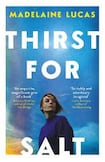
In Thirst for Salt, the debut novel from Madelaine Lucas, an unnamed narrator tells her own love story. The story is a blend of two familiar types: first love and a relationship between a young woman and an older man. Lucas engages the relevant tropes – daddy issues, a Madonna-whore complex – and the book could be read as a consideration of archetypes. While the novel doesn’t probe for revelations, it pursues an immersion in memory.
The narrator meets Jude (42) while vacationing with her mother after graduating university. She’s been raised in “a world of women”, but in the pressing heat and oceanic breath of the fecund Australian coast, everything is newly erotic. She first sleeps with Jude after he rescues her from a jellyfish sting; they have sex as he soothes her wounds. When she moves into his A-frame house, she’s submerged in a dimension of mature masculinity, in scenes of her long silk dresses hanging among his blue plaid and red flannel. Soon, she’s imagining their children, neglecting condoms, envisioning a life of writing and homemaking. When the relationship ends several months later, the narrator returns to her mother’s home and discovers she’s pregnant. Her mother accompanies her to the abortion.
Hindsight rarely intrudes on the love story. When it appears, it doesn’t judge the 24-year-old woman
The writing is rich, sensuous, and attentive. Lucas’s syntax is full of asides and elaborations and there’s no punctuational divide between dialogue and observation. This elides the barrier between memory and experience. It raises a question: is the truth about a relationship what was said, what was done, or forever lost to how everything was perceived?
The relationship narrative is bookended by passages wherein the present-day narrator – now 37, a successful author, single – is writing and worrying about her diminished ovarian reserve. Still, hindsight rarely intrudes on the love story. When it appears, it doesn’t judge the 24-year-old woman, nor does it press a connection between the narrator’s abortion and her enduring hope for children. As a novel that illustrates the need to organise life into narrative, such fealty to the past self is refreshing. Equally, it eschews resolution or a new understanding of the relationship. There are few drugs more potent and long-lasting than a first love with a keen power imbalance, and the narrator’s goal is to remember and distil a feeling. With a title that speaks to craving what makes you crave, Thirst for Salt asks a perennial question: “What if we had made it?”









